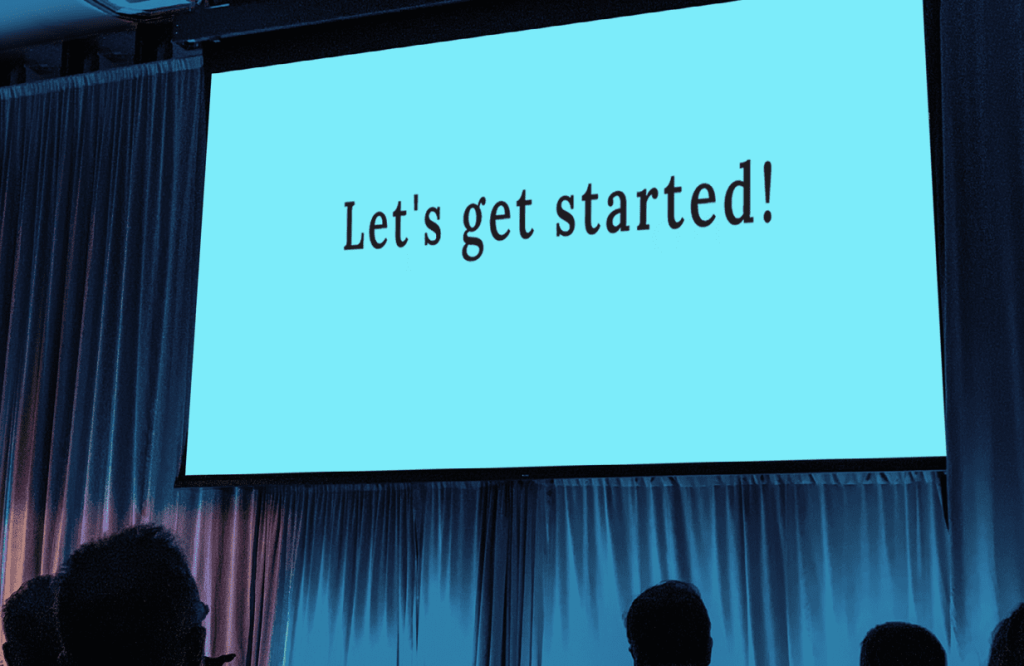Last slide – full impact
Tips and ideas for your final PowerPoint slide
By the time you start creating the last slide of your PowerPoint presentation you can sometimes run out of ideas. At least, there’s no other real explanation for the many concluding slides on presentations which show a lack of ambition. However, that last slide of the deck should offer a lasting impression and really shake things up. It should support the main objectives of your presentation as well as possible. Read our tips for results-oriented, effective ways to use the final slide.

Final PowerPoint slide – the end or a new beginning?
First impressions count, but it’s the last impression that really lasts – including for PowerPoint presentations. Those who believe they can get away with a mediocre introduction are just as wrong as those who fail to attach any importance to the very last slide of their presentation. Yet it’s so typical to round off a presentation with a slide simply stating, “Thank you for your attention!”, “Let’s begin the discussion” or just “Any questions?”. And what do these three examples have in common? They’re very unlikely to stick in the audience’s mind – and seem to announce that the presentation has come to an end. Listeners are practically invited to shut the door on the presented topic, put it out of their minds and move on with their day. This contradicts the very purpose of a presentation. The intention behind conducting a presentation is usually to make a fresh start and very rarely to conclude something. They’re used as a kick-off, to showcase information as a basis for decision-making, as a tool to win new clients. In all of these cases the end of the presentation in particular is a new beginning – for a process, a project, collaboration between partners, or a new contract or sales transaction.
Don’t miss the opportunity to use that final slide as a smooth transition to negotiations, actions, decisions and the changes you want to bring about. It’s therefore important to have a clear idea of the goal of your presentation.
Your goals in sight – including the last slide in PowerPoint
There’s a purpose for every presentation you create. And where there’s a purpose there’s also a goal that you want to achieve with your presentation. When working on a presentation it’s important to keep this goal in mind from the first and right through to the very last slide. This helps you in the structure of your slides, the prioritization of the most important information, the collaboration with others in presentation creation and, of course, in the design of that final slide.
The last slide of a presentation will ideally contribute to achieving your original goal. Below, using three examples, we show you how identifying the goal for a presentation and measures on how to meet that goal can really affect how you use the very last slide to contribute to this.
There are three typical objectives for creating presentations:
Goal of presentation: To inform

You want to share knowledge with others. You have achieved your objectives when your audience have understood all the information and have reached the level of knowledge you intended.
Example presentations would be:
- Presentations for training purposes
- Presentations on research results or findings
- Presentations on project updates
- Reports and quarterly updates
Ideas for concluding slide
- Use the last slide of a presentation as a reminder. Provide a succinct recap of the most important information the audience needs to remember.
- Turn the obligatory “Any questions?” on its head and instead ask your listeners if they feel well-informed, that they have taken in everything you presented to them.
- Address those who seem particularly interested by sharing further sources of relevant information (literature, videos, upcoming events).
Goal of presentation: To convince

There are different standpoints on a topic. You would like to bring your arguments into the discussion. The objective has been achieved when you gain support for your viewpoints among the audience.
Example presentations would be:
- Project proposals
- The presentation of ideas within a context of innovation management
- Keynote speeches and lectures
Ideas for concluding slide
- Revisit a point or an image from the introductory section of your presentation to round it off and show you consistently stand by your argument.
- Conclude with an attention-grabbingdeas for concluding slide image or a quote which symbolically supports your viewpoint to leave a strong, lasting impression.
- Use your closing slide to outline the desired outcome or status. Your personal vision for a better (working) world.
Goal of presentation: To motivate

The most challenging objective for a presentation is to stir your audience into action. The goal has been reached when the intended action has been triggered.
Example presentations would be:
- Sales presentations with the intention of closing a sale.
- Decision-making presentations for a management board.
- Presentations for the approval of a budget.
Ideas for concluding slide
- Let that last slide encourage the audience to put money where their mouth is. List all the decisions which need to be made and add check marks for approval.
- Take the next step: For instance, show a fixed date for signing a contract on the last slide.
- Connect with prospects on the last slide with a summary of what’s interesting and relevant for them and how they specifically benefit from signing a deal (or other actions you would like them to take).
If you want to know how to set up your slides well from start to finish, please read our other blog article on creating a clear structure for successful presentations here.
Storyboarding helps you to keep sight of the common thread of your presentation. Learn how to use storyboards to build better presentations here.
Dos and Dont’s for the final PowerPoint slide
Here are a few more tips to keep in mind when creating the last PowerPoint slide of your presentation.
Dos:
- Think ahead as to what would make an effective closing slide which corresponds to your presentation objectives. This way you can avoid resorting to a lame slide showing, “Thanks for your attention” due to lack of time and inspiration close to a deadline.
- Of course, you can thank your audience, but do this verbally as part of your presentation delivery, thus making it more personal and sincere.
- Avoid seeing the concluding slide as an endpoint to your presentation and instead see it as a transition point to the next steps, for example, by providing an outlook or setting a schedule for decision-making.
Don’ts:
- Do not introduce a new topic on the final PowerPoint slide. This can irritate your listeners and even generate unnecessary discussions. Instead, summarize, repeat or confirm the key messages stated on previous slides.
- Avoid the awkward situation that may arise by encouraging your audience to ask questions right at the end when their minds are already on making it to their next meeting. Instead, provide those with questions with an opportunity to raise them afterwards so those in a hurry have a chance to leave.
- Don’t use the final slide to present any gags, memes, animations or gimmicks which only serve to gain attention. Instead, keep it relevant and use it a useful tool to meet your objectives.
Our blog articles provide you with many helpful tips on presentation creation.